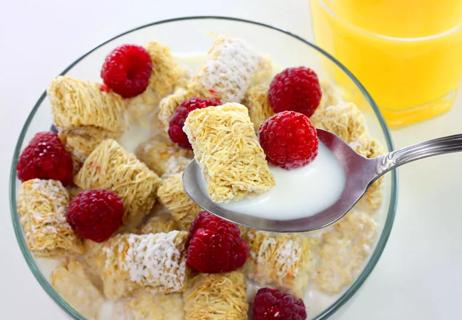Information on serving size, calories and nutrients can help you make healthy choices

If you want to really know what you’re eating, take the time to read the nutrition label on the package.
Advertisement
Cleveland Clinic is a non-profit academic medical center. Advertising on our site helps support our mission. We do not endorse non-Cleveland Clinic products or services. Policy
This information-packed box of text and numbers breaks down what’s in food and drinks. If you know what to look for, the process of putting together nutritious and healthy meals can be much easier.
Let’s take a closer look at what you can learn with the help of registered dietitians Kayla Kopp, RD, LD, and Beth Czerwony, RD, LD.
Nutrition labels are meant to be helpful tools for making healthy food choices. The U.S. Food and Drug Administration (FDA) revamped the “Nutrition Facts” label in 2016 to help people know what they’re putting into their bodies.
There’s a lot of information jammed into the small, rectangular boxes printed on packaged foods and drinks. Here’s what you’ll see and what you can gain from it.
What you consider one serving of your favorite food may be … well, MORE than one serving as defined by the FDA.
The serving size noted on a product’s nutrition label reflects the amount of the food people typically consume in one sitting. It could be listed as a count (such as 15 crackers). It might be done as a ratio (like 1/4 of a pizza). It may be by volume (as in cups or fluid ounces).
Sounds simple, right? Unfortunately, misjudging serving size is common. “People routinely underestimate what a serving is,” says Kopp. “More often than not, you’re probably eating more than one.”
Advertisement
Given that serving size provides the foundation for the rest of the nutrition label, that’s a significant issue. Information on calories, fats, nutrients and more is based on what’s defined as a serving.
To help consumers, some nutrition labels now include a row of facts based on the contents of the entire package. Anyone who has wiped out a pint of ice cream in a single sitting understands that logic.
“It’s an addition based on what people might eat,” notes Czerwony. “It gives a better understanding of what you’re eating without requiring you to do math based on the number of servings in a package.”
If you want to get a handle on serving size, Kopp suggests measuring your foods and drinks to see what’s considered a single helping. (WARNING: The results may surprise you.)
It’s hard to miss calorie counts on nutrition labels. They’re highlighted in BIG BOLD PRINT at the top of nutrition labels. There’s a reason for this, too: Calories are extremely important for health.
Let’s start with the basics: Calories measure energy. The calorie number you see on a nutrition label reflects the available energy in foods and drinks, explains Kopp. You need to consume calories for your body to function.
But the key is balancing the calories you take in with the calories your body burns as fuel. Eating more calories than your body uses can lead to obesity and overweight and related health issues.
A diet of 2,000 calories a day is considered adequate for most people. But individual calorie needs can vary greatly depending on a person’s age, sex, height, weight and activity level.
So, with that as background, how can you use calorie counts on nutrition labels to help make meal choices?
In general, says Kopp that a food with about 100 calories per serving is a moderately caloric food that fits into a healthy diet. Try to avoid or limit high-calorie foods that have 400 or more calories per serving.
And as noted, keep serving sizes in mind when calculating total calories. “If you eat a package of cookies that contains three servings, you’ve eaten three times the number of calories listed on the nutrition label,” says Kopp.
Information on key nutrients fills the center of nutrition labels. Some of these nutrients — such as dietary fiber, calcium and vitamin D — are important for good health yet often lacking in people’s diets.
Other listed nutrients — like saturated fat, added sugars and sodium — are often over-eaten and linked to various health conditions.
Advertisement
Let’s take a closer look at what you can learn and how you can use that knowledge.
The largest number you’ll see here is for total fats, but it’s not the most important piece of information. “The real key is saturated fats and trans fats,” says Czerwony. “Those are the ones that can contribute to heart disease and other health issues.”
Food high in saturated fat includes fatty cuts of beef and pork or poultry with skin, plus animal-based food such as eggs and full-fat dairy products. Baked goods, fried foods and many highly processed snacks are also chock full of it.
Ideally, saturated fats should account for no more than 5% to 6% of your daily caloric intake, which equals about 100 to 120 calories. (A gram of saturated fat is 9 calories, so multiply the grams of saturated fat in a product by 9 to calculate calories from saturated fat.)
As bad as saturated fats are, trans fats are worse. That explains why the FDA banned them in 2018. But small amounts can still be found in some packaged foods.
Globally, it’s estimated that nearly 40% of the adult population has high cholesterol (hyperlipidemia). This excess of lipids (or fats) in your blood increases the risk of heart attack and stroke.
Advertisement
So, should you be watching this number closely? It might not be necessary if you’re watching your saturated fats. “Most foods that are high in dietary cholesterol are also high in saturated fat,” says Kopp.
But if you do want to track cholesterol intake, it’s best to stay below 300 milligrams (mg) of cholesterol a day on the typical 2,000-calorie diet.
In many ways, sodium (and salt) gets a bad rap. The truth is your body needs sodium. It’s an important electrolyte that balances fluid levels in your body and helps your nerves and muscles work well.
But the problem is that most of us consume too much sodium. Overdoing it can contribute to health issues such as high blood pressure, stroke and kidney damage.
Kopp suggests keeping sodium intake to less than 600 mg for each of your three daily meals and less than 200 mg for two daily snacks. (It’s recommended that daily consumption stays below 2,300 mg.)
If you start looking at labels, you might be surprised to see where sodium hides. Examples of high-sodium foods include:
Carbohydrates can be complicated, with a good side and a not-so-good side. The nutrition label offers a glimpse at both with information on dietary fiber (the good) and sugar (not-so-good).
Advertisement
People with prediabetes and diabetes often need to closely watch the consumption of carbohydrates, which raise blood sugar.
Protein deficiency usually isn’t an issue for most people given typical diets, but it’s possible to go overboard. Kopp recommends aiming for 20 to 30 grams of protein per meal. (Needs may increase if you’re trying to build muscle or recover from an injury.)
Vitamins and minerals help your body grow, develop and work properly. Depending on the product, a nutrition label may list up to 14 different vitamins and 14 different minerals.
But all nutrition labels must include the following nutrients, which many people are lacking in their diet:
Health officials have called the vitamins and minerals listed above “nutrients of public health concern.” Low intakes of them can lead to serious health problems like anemia, osteoporosis, high blood pressure and heart disease.
The righthand column of a nutrition facts label lists the percentage of the daily value (written as % DV) for each nutrient in one serving of a food or drink. You can use this number to figure out whether a food is high or low in a particular nutrient.
A nutrient with a 5% DV or lower is considered to have a low daily value. A nutrient with a 20% DV or above has a high daily value.
Overall, it’s generally better to have a:
When you understand how to read a nutrition label correctly, it can help you compare and choose between different brands or similar products. Learning how the numbers on the nutrition label affect your overall health can help you make informed grocery purchases.
“View nutrition labels as a trusted source of information,” says Czerwony. “Educate yourself on them. It takes a little bit of time, but it’s a small investment given what it can mean for your health.”
Learn more about our editorial process.
Advertisement

An occasional shopping spree can boost your mood by distracting you from stressors and pumping your brain full of ‘happy hormones’

Signs you’re a compulsive spender include lying about purchases, buying things you don’t use and treating shopping like a hobby

Whole-grain options low in sugar and sodium form the foundation of a good-for-you breakfast

From planning ahead to resisting bargains, these tips could also save you money

All it takes is a little planning

Avoid bringing bacteria home

4 ways to identify foods that are (actually) good for you

Edamame, lentils and chicken breast are good sources of protein

The best parenting style balances enforcing rules and showing plenty of love

Tips include cutting back on sugar, focusing on exercise and managing stress

It can be harder to let go when you’ve invested time, energy and emotions — but it might be the healthier choice long term